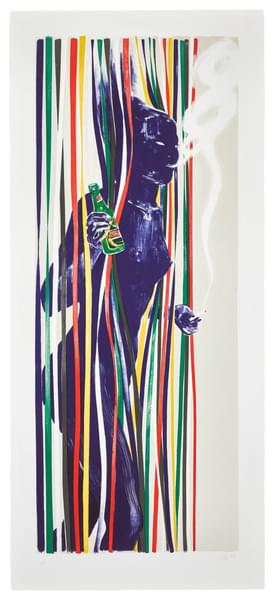Untitled (after Ophelia)
Employing a multitude of borrowed art historical references, Brice depicts strangely familiar scenes in new and often unsettling ways. Where figures might previously have been depicted as objectified nudes or damsels in distress, Brice recasts them in new situations with a sense of autonomy. Brice has discussed the significant fact that historical figuration in Western art history is, more often than not, created by white men for white men. For her, the act of a woman re-authoring an image which was previously painted by a man about a powerful shift in itself.
This subversion of misogynistic visual tropes from the canon of Western art history is key to Brice's practice. The main figure in this work references Ophelia by John Everett Millais. In the painting by Millais, a heartbroken Ophelia lies lifeless, having drowned in a stream. Brice has resurrected Ophelia from her watery grave and she leans nude through a brightly coloured plastic curtain used to keep mosquitoes out. Plumes of smoke billow up from the cigarette she holds nonchalantly whilst drinking a bottle of Trinidadian Stag beer pitched in Trinidad as a 'man's beer' .
For Untitled (after Ophelia), 2020, Brice has combined the art historical with a sense of Trinidadian life. Since 1999, when Brice first attended a workshop in Grande Riviere, and a residency in POS the following year, she has maintained strong ties with the island. Brice often references Trinidad in her work, one recurring reference being a particular shade of blue. For Brice, the colour hints at the sense of liberation experienced by those masquerading as Blue Devils during Carnival, or when revellers coat themselves with mud or paint for J'ouvert a celebration which marks the beginning of Carnival freeing themselves from the limitations of their own character. The blue paint is possibly made from Reckitt's powder, which historically was used throughout the colonies of the British Empire for blueing white cloth. The powder has also been associated with skin bleaching, something that takes on particular relevance considering Brice's connection to Trinidad where shadeism discrimination based on degrees of skin colour is prevalent. Brice's use of blue interrupts easy readings of ethnicity. Blue also has a plethora of art historical associations it is traditionally the colour of the Virgin Mary's cloak in religious iconography; for Henri Matisse, the colour allowed him to focus intensely on the female form; and Yves Klein employed his own trademarked shade to make paintings using women as living paintbrushes. Brice's work consistently defies straightforward interpretations; her bold and defiant characters refuse to be pinned down.
Untitled (after Ophelia)
- Artist
- Lisa Brice (b.1968)
- Title
- Untitled (after Ophelia)
- Medium
- Lithograph in colours on wove paper
- Date
- 2020
- Sheet Size
- 34 x 15 in : 86.4 x 38.1 cm
- Framed Size
- 36 ¾ x 17 ¾ in : 93.5 x 44.8 cm
- Edition / Inscriptions
- From the edition of 50, signed, dated and numbered by the artist in pencil
- Publisher
- Published by Tate, London
- Reference
- A22-14
- Download PDF
- Status
- No Longer Available
Available Artists
- Albers Anni
- Ancart Harold
- Andre Carl
- Avery Milton
- Baldessari John
- Barnes Ernie
- Calder Alexander
- Castellani Enrico
- Clough Prunella
- Crawford Brett
- Dadamaino
- de Tollenaere Saskia
- Dyson Julian
- Elsner Slawomir
- Freud Lucian
- Gadsby Eric
- Gander Ryan
- Guston Philip
- Haring Keith
- Hartung Hans
- Hayes David
- Held Al
- Hepworth Barbara
- Hill Anthony
- Hitchens Ivon
- Hockney David
- Hutchinson Norman Douglas
- Jenney Neil
- Katz Alex
- Kentridge William
- Knifer Julije
- Kusama Yayoi
- Le Parc Julio
- Leciejewski Edgar
- Léger Fernand
- Levine Chris
- Marchéllo
- Martin Kenneth
- Mavignier Almir da Silva
- Miller Harland
- Mitchell Joan
- Modé João
- Moore Henry
- Morellet François
- Nadelman Elie
- Nara Yoshitomo
- Nesbitt Lowell Blair
- Nicholson Ben
- O'Donoghue Hughie
- Pasmore Victor
- Perry Grayson
- Picasso Pablo
- Pickstone Sarah
- Prehistoric Objects
- Riley Bridget
- Ruscha Ed
- Sedgley Peter
- Serra Richard
- Shrigley David
- Smith Anj
- Smith Richard
- Soto Jesús Rafael
- Soulages Pierre
- Spencer Stanley
- Taller Popular de Serigrafía
- The Connor Brothers
- Vasarely Victor
- Vaughan Keith
- Whiteread Rachel
- Wood Jonas

